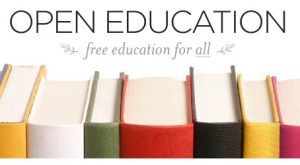
According to Michael Mcnally Open Education Resources “Are digitized materials offered freely and openly for educators, students and self-learners to use and reuse for teaching learning and research” (Mcnally, 2012). I believe overall this is a fantastic idea and one that can help eliminate financial, location based, and academic barriers for students looking to better themselves and gain knowledge. It also provides a great resource for parents and educators to collaborate, find and share educational tools that and ideas. I think the fact that it is open and growing, is the most exciting part of the movement. The idea that people are working and building resources to provide free classes and resources to those that seek them restores hope for the future. The thought that anyone could take classes and use this information to teach themselves and learn from institutions like MIT and other world renowned universities is almost philanthropic.
Problems arise when you consider who are aware of these resources, have access to them and understand them. The citizens of the world that are uneducated and would benefit the most from free materials and classes, may not have access to these resources, they may not understand them, and may not even realize they exist. The free classes are great for those that are interested, but they provide no ‘college credits’ or translatable skills in the real world, other than the value of the knowledge itself. They are still great resources, but they may not make an impact on the world at large. Mcnally listed several other problems: the tendency for resourceful corporations or individuals to capitalize on free research in order to profit from it, the need for scrutiny to avoid misinformation, and the opposite train of thought that research is a valuable resource that should be capitalized on. Then there is also the cost of creating, maintaining, and sustaining these resources.
My overall conclusion is that these open education resources are great tools for those that seek out knowledge on their own for its intrinsic value, or for educators or parents to share tools, applications and information to help teach children or students. The internet or the library, themselves are open education resources, they have a near endless supply of knowledge, yet despite how much knowledge you gain, it does not translate into real-world applications. The users of these tools also must be able to discern fact from rumor or fiction in order to gain any value at all. I think that the idea behind free education, resources, and research is wonderful, but unless these resources can make evolve further, they will just be what they are another resource like the internet, research databases, libraries, and the like. Overall I think Open Educational Resources are fantastic tools. The whole idea of free education is a fantastic idea, and its great that its actually gaining traction and producing results. Now if we can just get the masses to participate and become lifelong learners…
This was a great learning activity. It brought a set of tools, resources, and a movement to my attention that I was previously unaware of. I explored the OER commons which had a vast library of tools for educators, parents and students to use to learn. The discussion we all participated in was engaging and informative. I gained a lot of insight from reading my fellow students’ posts and responses. This website we have created and are blogging on, is also a great resource for ourselves in the future.
What do you think the next step is to really take Open Education to the next level and continue the movement?



